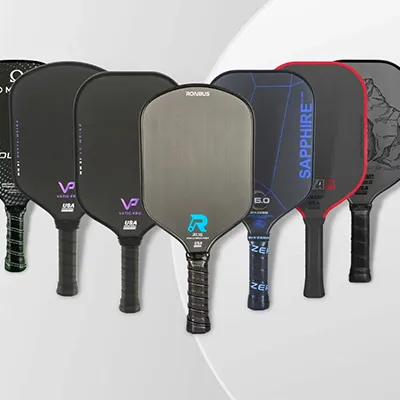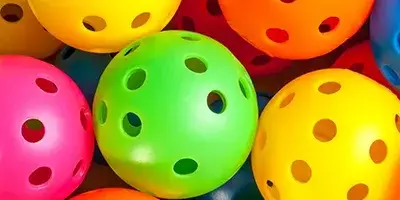Learn the Basics
A Pickleball Court is the same size as a badminton court with an additional non-volley-zone line. The court is split into a two sides by a low net.
Points can only be scored by the side that’s serving, and points are scored if the opposing player:
Fails to return the ball.
Volleys in the non-volley zone.
Hits the ball out of bounds.
Hits the ball into the net.
Volleys the ball before it bounces at least once.
The start of each pickleball game begins with a serve – and the player standing on the right side of the court always serves first. To serve, you must hit the ball underhanded into the opposing player’s court – but importantly, the serve must clear the net and not land in the ‘kitchen’. The ‘kitchen’ is the nickname of the non-volley zone closest to the net. This is marked by a clear line, so you’ll always know where you should and shouldn’t stand.
A crucial pickleball rule is the double bounce rule: this states that the ball must bounce once before either player or team can volley the ball over the net. When returning the serve, the opposing player or team must also let the ball bounce once before returning it over the net. Essentially, the whole point of the game is to hit the ball back and forth until someone makes a mistake – it’s that simple!
The game is won when one side reaches a score of 11… as long as they’re leading by at least two points. If they’re not, the game continues until one side is two points ahead.
OFFICIAL RULES
Pickleball is fast, fun, and easy to learn — but like any sport, it has rules that ensure fair play and a great experience for everyone. Whether you're new to the game or brushing up before a tournament, here's a simple guide to help you understand how it's played.
The Basics
Pickleball is played either singles (1 vs 1) or doubles (2 vs 2) on a court similar in size to a badminton court with a lower net (34 inches at the center).
-
The Serve: Underhand, hit diagonally into the opposite service box. Only one serve attempt is allowed (except in doubles’ first service rotation).
-
The Double Bounce Rule: After the serve, each team must let the ball bounce once before volleying. This means the ball must bounce once on each side before any volleys.
-
Volleys: Players can hit the ball out of the air only when they’re outside the Non-Volley Zone (also called the Kitchen).
The Kitchen Rule
The Non-Volley Zone (7 feet from the net on each side) is a special area. You cannot:
-
Volley while standing in it or touching the line.
-
Step into it after a volley (momentum counts!).
You can enter the kitchen to play a ball that has bounced.
Scoring
-
Only the serving team can score points.
-
Games are typically played to 11 points, win by 2. In some events, games may go to 15 or 21.
-
In singles, players serve from the right when their score is even, and the left when it’s odd.
-
In doubles, teams have two serve turns (except the first round of the game), and players switch sides after scoring a point.
Tournament Play
Pickleball Ireland events often follow the International Federation of Pickleball (IFP) or USA Pickleball rules. These include:
-
Line calls: A ball touching any part of the line is considered in.
-
Let serves: No longer used — if the ball hits the net and lands in the correct box, play continues.
-
Timeouts and substitutions: Allowed depending on format.
You can always download the full official rulebook at usapickleball.org.
Want to Improve?
-
Join a local Pickleball 101 session or club night.
-
Watch online tutorials or rule explainer videos.
-
Ask experienced players — our community is always happy to help.
Pickleball Ratings Explained
Understanding your skill level is an important part of playing and improving in pickleball. In Ireland, players typically use two systems to identify their playing level: Self-Rating and DUPR (Dynamic Universal Pickleball Rating).
Self-Rating
Self-rating is a simple way to estimate your own skill level based on your playing experience, strategy, and consistency. This is especially useful for entering tournaments, joining appropriate leagues, or forming evenly matched teams.
Common Self-Rating Levels:
-
1.0 – 2.0: Beginner – Just learning the game, limited understanding of rules.
-
2.5: Novice – Can sustain a short rally, learning court positioning.
-
3.0: Recreational – Understands basic strategy, can execute dink shots and serves with some consistency.
-
3.5: Intermediate – Good control of shots, starting to use drop shots, improved movement and teamwork.
-
4.0: Advanced – Consistent and strategic play, uses soft game effectively, quick transitions.
-
4.5+: Competitive/High Performance – Strong shot variety, minimal unforced errors, tournament experience.
Note: For most events organised by Pickleball Ireland, players will be asked to select a division based on this self-rating scale unless a verified DUPR is used.
DUPR Rating (Dynamic Universal Pickleball Rating)
DUPR is an international rating system that gives you a more accurate and dynamic reflection of your skill level, based on your match results, not just your opinion.
Key Features:
-
Accurate: Based on results from recreational play, leagues, and tournaments.
-
Universal: Works across countries, clubs, and skill levels.
-
Dynamic: Updates after each match to reflect performance over time.
How to Get a DUPR:
-
Create a free DUPR account at www.mydupr.com.
-
Play in DUPR-compatible events (many Pickleball Ireland events submit results to DUPR).
-
Log your results (you can even enter scores from verified recreational games).
-
DUPR will automatically calculate your rating after a few matches.
DUPR ratings range from 2.00 to 8.00 and update regularly.
Which Should I Use?
-
New players should start with Self-Rating.
-
Competitive players or those entering national/international events should aim to get a DUPR rating.
-
Many Pickleball Ireland events will use both systems to place players in the correct divisions.

Paddles
When playing pickleball, each player will need a pickleball paddle, which is smaller than a tennis racquet but larger than a ping-pong paddle. Originally, paddles were made only from wood, however, today’s paddles have evolved dramatically and are primarily made of lightweight composite materials, including aluminium and graphite.
There are 100s of different paddles for you to choose with all with varying shapes, sizes, grips and weights. We recommend you check out some of our preferred partners to see what paddles they have available.
With so many innovations in paddles every month, it's important to always check that your paddle is an approved paddle. While non-approved paddles are fine for recreational play, only approved paddles are allowed to be used at official tournaments and events.
Courts
In Ireland, the majority of our players play on an indoor badminton court. While the outer dimensions of the court are correct, in order to play to regulation an additional non-volley zone line 7ft either side of the net must be added in tape.
For those looking to construct your own court, check out the court construction guide below.
Nets
Matches are typically played using temporary nets that can be set-up and taken down easily. Similar to paddles, there are a number of regulations that need to be taken into account when setting up a net. Buying official Pickleball nets will make it easier to comply with the rules.
The net can be made out of any mesh material that will not allow a ball to pass through. It should be at least 21ft 9" long, stretching from post to post; from the bottom edge to the top, it should be at least 30" wide. The posts should be 22ft apart & no more than 3" in diameter.
Once suspended from the posts across the centre of the court, it should be 36" tall at the sidelines, and 34" tall in the centre. The top edge of the net should have a cord or cable & it should be covered with a 2-inch tape.
Pickleballs
There are a number of different balls available on the market today. Many colours are available as well as different constructions. Outdoor and indoor pickleball balls have distinct differences in their construction, which can significantly affect the way they behave on the court.
Indoor pickleballs tend to have 26 holes per ball, while outdoor balls have 40 holes.


